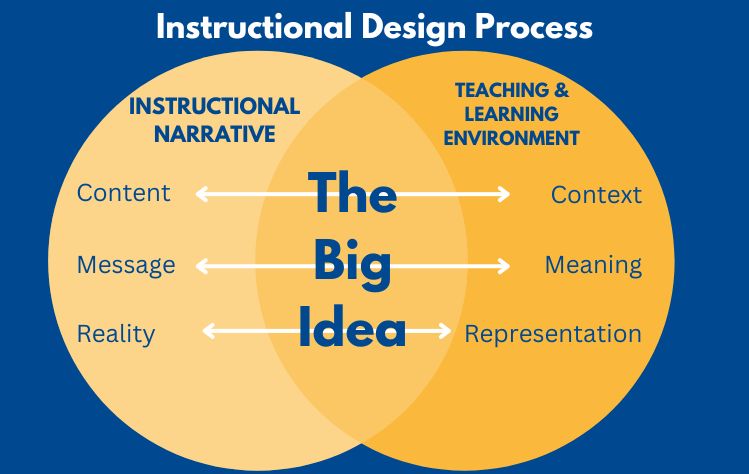How to Come Up with a BIG IDEA
May 31, 2024

Image Transcript
The Instructional Design Process shows a Venn diagram with Instructional Narrative and Teaching Learning Environment.
The Instructional Narrative circle includes content, message and reality.
The Teaching Learning Environment circle includes context, meaning and representation.
Where the two circles overlap is “The Big Idea,” linking content to context, message to meaning, and reality to representation.
By Basiyr Rodney, PhD, Webster University, St. Louis, Missouri, USA and Yupa Saisanan, EdD, Webster University, St. Louis, Missouri, USA
 For anyone aiming to develop their professional-level creativity, or Pro-C, it’s important
to understand that creativity is not simply an intuitive or natural-born asset. Instead,
it’s a skill that can be learned and nurtured over time.
For anyone aiming to develop their professional-level creativity, or Pro-C, it’s important
to understand that creativity is not simply an intuitive or natural-born asset. Instead,
it’s a skill that can be learned and nurtured over time.
In lay terms we think of creativity as “thinking outside of the box,” but this frame ignores the fact that professional creativity can be cultivated through practice and experience.
 The journey to creativity begins with identifying a problem, and the BIG IDEA is the
innovative solution that emerges in response to this challenge. Achieving a BIG IDEA
requires the ability to perceive and conceive ideas beyond conventional constraints,
employing a curious mind and non-conformist mindset to uncover novel insights.
The journey to creativity begins with identifying a problem, and the BIG IDEA is the
innovative solution that emerges in response to this challenge. Achieving a BIG IDEA
requires the ability to perceive and conceive ideas beyond conventional constraints,
employing a curious mind and non-conformist mindset to uncover novel insights.
Sparking a BIG IDEA with the 4C Model of Creativity
The 4C Model of Creativity (Kaufman and Beghetto, 2009) — comprising Mini-C, Little-C, Pro-C, and Big-C — offers a comprehensive framework for understanding creativity. Pro-C or professional-level creativity, is particularly relevant when aiming for a BIG IDEA in the context of learning designs and instructional problems. Pro-C represents creativity that is developed and recognized within a professional domain, reflecting significant expertise and impact.
Here are five essential questions to help spark your BIG IDEA through the lens of Pro-C creativity:
1. Is the big idea informed by knowledge in my field?
Insight is the foundation of your idea. It grounds your thoughts and provides a frame of reference for your solutions. In learning design, this insight might relate to understanding how students engage with content or identifying specific barriers to effective learning. It encompasses the beliefs upon which your instructional strategies rest and the cumulative goals that you want your learner-participants to grasp. Field based insights also relate to difficult problems or gaps within the field for which creative solutions are needed.
2. Is the big idea original and appropriate to my learning domain and context?
A BIG IDEA is a creative solution that stands the test of time. It’s grounded in a compelling thought that provides a framework for your instructional narrative — the goal of the intended learning design. This can be expressed in various forms, such as a new teaching method, an innovative use of technology, a unique classroom activity or an engaging multimedia resource. The idea should be original while fitting well within the specific context of your educational environment. For example, game-based learning approaches have long provided deep learning and engagement. In the digital age, gamification and simulations are adding value to many learning contexts.
3. Does the big idea relate to improving products, processes or procedures in my context?
A BIG IDEA must address a tangible need within your educational setting. Whether it’s enhancing a particular aspect of curriculum design, improving teaching methodologies or streamlining educational processes, the idea should contribute to meaningful improvements.
For example, flipped classrooms have redefined instructional processes by promoting active engagement and more learner-participant-centered practices.
4. Would learners find the idea valuable and interesting?
A BIG IDEA must be compelling and dynamic, capturing attention and arousing curiosity. It should draw students in, make them think and prompt more questions rather than just providing answers. Real-world challenges, scenarios and cases often embedded in project-based learning provide more relevant and interesting experiences.
5. Is the idea memorable for learners?
Is the idea memorable for learners? Memorability is crucial. A BIG IDEA should be
simple, yet impactful, resonating deeply with learners. If a BIG IDEA for a lesson
focuses on a timeless concept like “love at first sight” or “a mystery worth solving”
they focus the brain on the compelling story behind the learning.
Memorable learning also leads to better remembering and transfer, which allows the
learner-participant to take current knowledge and apply it to new domains. Big ideas
that pull together multiple domains like STEAM promote transfer long after the learning
session is over.
Integrating Pro-C into Your Creative Process
To achieve Pro-C level creativity in learning design, you need to develop your expertise within your domain, continually refining your skills and knowledge. This involves:
Deepening Expertise: Continuously learning and mastering your field to develop a nuanced understanding of its challenges and opportunities.
Seeking Feedback: Regularly seeking constructive feedback from peers, mentors and students to refine your ideas and approaches.
Experimenting Boldly: Being willing to take risks and experiment with new combinations and perspectives to generate innovative solutions.
Building Networks: Collaborating with other creative educators to gain diverse insights and enhance your creative process.
By using these five guiding questions and integrating Pro-C principles, you can determine whether you have come up with a BIG IDEA that truly reflects “thinking outside the box” and offers creative solutions to your instructional challenges.
